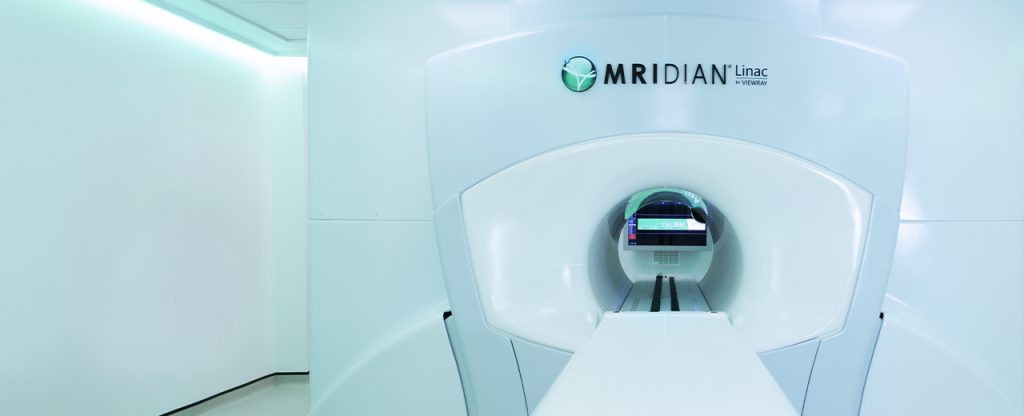University of Oxford, OUH and GenesisCare partnership enables access to state-of-the-art radiotherapy machine in Oxford
A new ViewRay MRIdian machine is the first of its kind in the UK and will help to improve challenging cancer treatment through faster, tailored radiotherapy
The first NHS patient has received treatment on the cutting-edge ViewRay MRIdian technology, thanks to a new partnership between the University of Oxford, Oxford University Hospitals (OUH) NHS Foundation Trust and GenesisCare.
The partners, with the support of the John Black Charitable Foundation, have collaborated to establish a ten-year programme of clinical treatment for NHS patients, with further research into improving cancer treatment using the Viewray MRIdian.
Due to the natural, unavoidable movement of soft tissue inside the body, normal tissue around the cancer can be exposed to radiotherapy treatment, particularly when targeting soft-tissue tumours deep within the body. It can be challenging to visualise these organs during radiotherapy with routine radiotherapy delivery.
The ViewRay MRIdian machine is the only one of its kind in the UK, with only 41 machines worldwide. It allows doctors to see the normal soft tissue and the tumour in real time by combining MRI scanning with targeted radiotherapy. Incorporating MRI scans will allow doctors to then tailor doses in real time to the specific internal anatomy of the patient on the day of treatment.
MRIdian technology also minimises the damage to surrounding healthy tissues by switching off when tumour tissue moves outside of the targeted beam. This could mean less side effects for patients and increased dosage of treatment delivered directly to the tumour.
GenesisCare, the University of Oxford and OUH will also partner in research collaborations to develop real-world evidence which will inform future utilisation of the MRIdian technology in hard-to-reach tumours, such as pancreatic cancers. The research partnership will assess the benefits of the MRIdian technology in terms of improved cancer outcomes and reduced toxicity.
Elizabeth Rapple, from South Oxfordshire, is the first patient to use the machine to treat her renal cancer, as part of the new partnership. She says:
“I feel very fortunate to be able to access this machine as part of a new Oxford-wide partnership. Any operation to remove my tumour would have been highly invasive, so it’s lucky that my cancer was suitable for MRIdian radiotherapy. I am so grateful that this unique machine has been made accessible through the NHS, and that I can be the first of many to benefit from this partnership going forward.”
Project leader Professor Tim Maughan, from the University of Oxford, said: “Treating patients on the MRIdian is like a surgeon putting on their spectacles for an operation – for the first time we can see exactly what the cancer is doing during treatment and adapt to change accordingly. This accuracy allows us to reduce side effects and we hope to improve cancer outcomes in hard-to-treat cancers.”
Dr James Good, Clinical Oncologist at GenesisCare, said: “The MRIdian machine is at the cutting-edge of what is possible in radiotherapy technology. The ability to visualise the tumour more accurately, to follow it while it’s being treated and to adapt the plan every day means we can deliver the best possible outcomes.
“This collaboration with the University of Oxford and Oxford University Hospitals will be truly beneficial for cancer patients in the UK. Not only will it provide patients who otherwise would have limited, or sadly, no options with a really viable treatment option, but we can also help demonstrate the effectiveness of this treatment, with the ambition to make it available for all NHS patients in the future.”
Carol Scott, Lead Therapeutic Radiographer & Deputy Clinical Director at Oxford University Hospitals , said: “OUH are excited to be part of this collaboration offering NHS patients the opportunity to take part in these clinical trials. The use of daily advanced imaging that clearly shows us the tumour and normal soft tissue around it will enable us to take the next step in making our treatments even more personalised and effective”
END
Editors Notes
Media enquiries
Interviews with Professor Tim Maughan are available on request. Audio interviews with Elizabeth Rapple are also available on request.
Please direct your enquires to:
Megan Harvey, Communications Officer
Email: megan.harvey@medsci.ox.ac.uk
Phone: +44 7485187131
About the University of Oxford
Oxford University has been placed number 1 in the Times Higher Education World University Rankings for the third year running, and at the heart of this success is their ground-breaking research and innovation. Oxford is world-famous for research excellence and home to some of the most talented people from across the globe. Their work helps the lives of millions, solving real-world problems through a huge network of partnerships and collaborations.
The MRC Oxford Institute for Radiation Oncology, within the University of Oxford’s Department of Oncology, aims to explore and utilise aspects of radiation biology research to improve the role radiation plays in cancer cure rates. We are applying a multi-disciplinary approach to enhance the efficacy of radiation, treat metastatic disease and accelerate patient throughput with AI and machine learning. We are ideally positioned to make seminal and transformative contributions to both understanding basic mechanisms of radiation biology as well as enhancing therapeutic efficacy in the next 5–10 years. We intend to exploit biological and technical advances which can enhance the impact of radiation treatment in curing cancer. The MRIdian project has been led from the MRC Oxford Institute for Radiation Oncology and will provide a key platform for future research, linked to the basic science discoveries within the Institute. As a world-leading centre dedicated to radiation oncology and biology, the Institute now has over 200 staff and postgraduate students – both clinical and non-clinical – and brings together research and clinical groups from a range of disciplines, including biology, chemistry, physics, medicine and computational biology.
About Oxford University Hospitals
Oxford University Hospitals NHS Foundation Trust (OUH) is one of the largest acute teaching trusts in the UK, with a national and international reputation for the excellence of its services and its role in patient care, teaching and research.
The Trust supports world-leading research programmes in cardiovascular diseases, musculoskeletal disorders, neurological disorders such as Parkinson’s and Alzheimer’s through its designation as one of the UK’s five comprehensive biomedical centres. It works in close partnership with the University of Oxford and is a leading centre for cancer, neurosciences, diabetes, genetics and many other fields. Research themes of particular strength are: cancer, cardiovascular science, diabetes, endocrinology and metabolism, infection and immunology, musculoskeletal science, neuroscience and reproduction and development.
This brings together academic research expertise with clinical teams to translate medical science into better healthcare treatments. Our patients benefit from world-class discovery and innovation supported by the NIHR Oxford Biomedical Research Centre, a partnership between the Trust and the University of Oxford, funded by the National Institute for Health Research.
The Trust employs over 12,000 staff and consists of four hospitals: the Churchill Hospital, John Radcliffe Hospital and Nuffield Orthopaedic Centre in Oxford and the Horton General Hospital in Banbury. On 1 October 2015 the Trust was awarded Foundation status and became Oxford University Hospitals NHS Foundation Trust. www.ouh.nhs.uk
About the MRIdian
The MRIdian®(also known as MR Linac) is manufactured by ViewRay, and is the only radiotherapy solution that can see and track soft tissue and tumours in real time. It delivers high-definition, diagnostic-quality imaging designed specifically to maintain high-fidelity beam delivery while virtually eliminating the risks of skin toxicities, trapped or distorted dose and other concerns that may occur when high magnetic fields interact with radiation beams. By shaping the dose to fit the day, it’s the only MR solution that enables integrated adaptive treatment for on-table reoptimization of the daily treatment plan.
There are currently 41 ViewRay MRIdian machines worldwide, with 1 in the UK at GenesisCare-Oxford.




